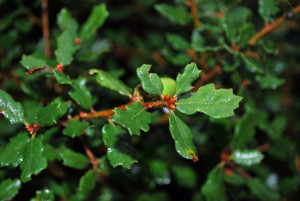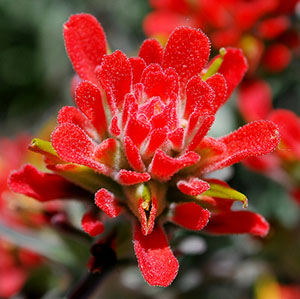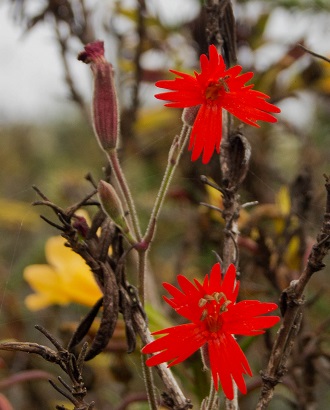Scrub oak is perfect if you have a dry, sunny yard and need to add some year-round greenery. It has handsome, grayish-green leaves that slightly resemble holly leaves. Scrub oak can grow up to 20 feet tall if it isn’t pruned yearly. Scrub oak is native to California, prefers a dry environment and can easily survive California droughts.

Scrub Oak: The Basics
Scrub oaks, also called Gambel oaks, survive by gathering what little water is naturally in the air via their leaves. They grow best in sandy or even rocky soil. Scrub oaks are often seen growing on hillsides in the wild. Left to grow naturally, they grow in thickets, with new trees growing from a single massive taproot. Scrub oak is a long-lived shrub. It thrives even in areas decimated by wildfires.
Animals and insects depend on scrub oak for shelter and food. Scrub oaks produce acorns that sustain squirrels throughout the winter. Butterflies are attracted to the scrub oak’s yellow flowers as a food source and then lay their eggs on its branches; the offspring eat the vegetation in their larval stage. Scrub oak is an attractive, drought-resistant shrub that’s important to our state’s environment and to our native animal life.
Landscaping With Scrub Oak
Scrub oak looks at home in a naturally landscaped yard. It’s especially attractive if you have a redwood, ranch style or traditional Southwestern style home, but scrub oak can work with nearly any style home. We recommend scrub oak to homeowners who want to work with native plants and attract wildlife to their yards.
Hardscapes and scrub oaks go great together. Native grasses add elements of natural drama to your sunny, dry yard. If you’ve decided to grow drought-resistant flowers, fruits or vegetables, having scrub oaks in the yard to attract butterflies will help your other plants survive and produce more blooms and fruits.
A retaining wall with pruned scrub oaks on top and flowering grasses at the base will instantly make a bare yard look lush. You can use scrub oaks as a hedge around your house, particularly under bedroom and bathroom windows, as long as you keep them pruned short. If you want shade, you can let your scrub oaks grow to their natural height of 15-20 feet. In addition to making your yard look great, trees or shrubbery combined with hardscapes increase your property value.
Caring for Scrub Oaks
Scrub oaks require almost no maintenance on your part. We’ll will prune them in the fall and trim them before the spring growing season starts. Experts recommend no watering for scrub oaks. We’ll examine them for any sign of insect infestation. Remember not to panic over the caterpillars in the spring, but call us if you see oak galls. This insect infestation should be treated.
Things to Remember
• Scrub oaks are drought-resistant
• They require almost no irrigation
• Scrub oaks grown well in adverse conditions
• Butterflies are attracted to scrub oaks
Fill out our contact form or call us at 805-773-5395 if you’re interested in scrub oaks for your yard or if you have any questions not covered in this article. Evergreen Landscaping will be happy to give you a consultation about the best types of the best drought-resistant trees and plants for your yard.

 Texas paintbrush blooms in spring and reseeds itself in autumn. The scarlet parts of the bloom aren’t petals or leaves. They’re called “bracts,” and they hide the actual flower, which is green and contains the seeds.The flower is often described as looking like a tiny pouch. Texas paintbrush tolerates drought well but will require a little water.
Texas paintbrush blooms in spring and reseeds itself in autumn. The scarlet parts of the bloom aren’t petals or leaves. They’re called “bracts,” and they hide the actual flower, which is green and contains the seeds.The flower is often described as looking like a tiny pouch. Texas paintbrush tolerates drought well but will require a little water. Are you longing for a brilliant pop of color for your drought resistant Pismo Beach garden? Cardinal catchfly, a native to our area, is a welcome alternative to succulents and wild grasses. Cardinal catchfly, also called Indian pink, Mexican pink and Mexican campion, is a saffron-colored flowering herb. Each stem bears multiple blooms.The blooms have long stamens that are fully revealed as the flower unfolds. Cardinal catchfly needs a bit of extra care compared to some other drought tolerant plants, but it also has some special qualities you’re sure to love.
Are you longing for a brilliant pop of color for your drought resistant Pismo Beach garden? Cardinal catchfly, a native to our area, is a welcome alternative to succulents and wild grasses. Cardinal catchfly, also called Indian pink, Mexican pink and Mexican campion, is a saffron-colored flowering herb. Each stem bears multiple blooms.The blooms have long stamens that are fully revealed as the flower unfolds. Cardinal catchfly needs a bit of extra care compared to some other drought tolerant plants, but it also has some special qualities you’re sure to love. Understanding basic
Understanding basic  Sea cliff buckwheat is a beautiful, perennial spreading shrub with blooms ranging from off-white to pale red. It typically grows to a height of about three feet and branches out to the same width. While it prefers sandy soil, it also does well in clay. It grows best at low altitudes. It is also called seacliff buckwheat, dune buckwheat, coast buckwheat and cliff buckwheat.
Sea cliff buckwheat is a beautiful, perennial spreading shrub with blooms ranging from off-white to pale red. It typically grows to a height of about three feet and branches out to the same width. While it prefers sandy soil, it also does well in clay. It grows best at low altitudes. It is also called seacliff buckwheat, dune buckwheat, coast buckwheat and cliff buckwheat.
 Foothill pine is a handsome evergreen that can grow to 80 feet tall. It’s also called California foothill pine, pinon pine, bull pine, nut pine and gray pine. The California foothill pine thrives in areas with poor soil and little water. The nuts, eaten raw or roasted or even ground into flour with other seeds, were a vital food source for Native Americans. Native Americans also used the pine pitch for medicinal purposes and the branches to fashion utensils and even in basket weaving.
Foothill pine is a handsome evergreen that can grow to 80 feet tall. It’s also called California foothill pine, pinon pine, bull pine, nut pine and gray pine. The California foothill pine thrives in areas with poor soil and little water. The nuts, eaten raw or roasted or even ground into flour with other seeds, were a vital food source for Native Americans. Native Americans also used the pine pitch for medicinal purposes and the branches to fashion utensils and even in basket weaving.
